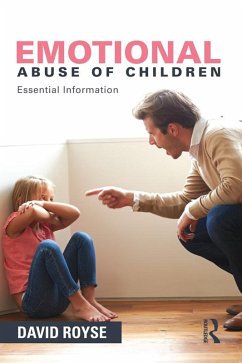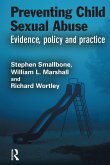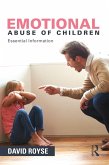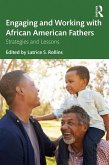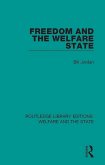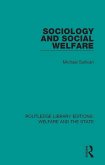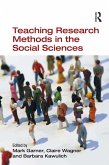39,95 €
39,95 €
inkl. MwSt.
Sofort per Download lieferbar

20 °P sammeln
39,95 €
Als Download kaufen

39,95 €
inkl. MwSt.
Sofort per Download lieferbar

20 °P sammeln
Jetzt verschenken
Alle Infos zum eBook verschenken
39,95 €
inkl. MwSt.
Sofort per Download lieferbar
Alle Infos zum eBook verschenken

20 °P sammeln
- Format: ePub
- Merkliste
- Auf die Merkliste
- Bewerten Bewerten
- Teilen
- Produkt teilen
- Produkterinnerung
- Produkterinnerung

Bitte loggen Sie sich zunächst in Ihr Kundenkonto ein oder registrieren Sie sich bei
bücher.de, um das eBook-Abo tolino select nutzen zu können.
Hier können Sie sich einloggen
Hier können Sie sich einloggen
Sie sind bereits eingeloggt. Klicken Sie auf 2. tolino select Abo, um fortzufahren.

Bitte loggen Sie sich zunächst in Ihr Kundenkonto ein oder registrieren Sie sich bei bücher.de, um das eBook-Abo tolino select nutzen zu können.
Children and Emotional Abuse is a research-informed learning resource for students in social work about the dynamics and consequences of psychological abuse-especially as it occurs in dysfunctional families and affects children and adolescents. Emotional abuse is still not widely understood or recognized. Helping professionals need to recognize emotional abuse, understand the damage it does, the theories that account for it, and be prepared to help children and families where the abuse often occurs along with physical and sexual abuse.
- Geräte: eReader
- mit Kopierschutz
- eBook Hilfe
- Größe: 2.26MB
Andere Kunden interessierten sich auch für
![The Receiving End (eBook, ePUB) The Receiving End (eBook, ePUB)]() The Receiving End (eBook, ePUB)35,95 €
The Receiving End (eBook, ePUB)35,95 €![Preventing Child Sexual Abuse (eBook, ePUB) Preventing Child Sexual Abuse (eBook, ePUB)]() Stephen SmallbonePreventing Child Sexual Abuse (eBook, ePUB)48,95 €
Stephen SmallbonePreventing Child Sexual Abuse (eBook, ePUB)48,95 €![Emotional Abuse of Children (eBook, PDF) Emotional Abuse of Children (eBook, PDF)]() David RoyseEmotional Abuse of Children (eBook, PDF)38,95 €
David RoyseEmotional Abuse of Children (eBook, PDF)38,95 €![Engaging and Working with African American Fathers (eBook, ePUB) Engaging and Working with African American Fathers (eBook, ePUB)]() Engaging and Working with African American Fathers (eBook, ePUB)34,95 €
Engaging and Working with African American Fathers (eBook, ePUB)34,95 €![Freedom and the Welfare State (eBook, ePUB) Freedom and the Welfare State (eBook, ePUB)]() Bill JordanFreedom and the Welfare State (eBook, ePUB)34,95 €
Bill JordanFreedom and the Welfare State (eBook, ePUB)34,95 €![Sociology and Social Welfare (eBook, ePUB) Sociology and Social Welfare (eBook, ePUB)]() Michael SullivanSociology and Social Welfare (eBook, ePUB)34,95 €
Michael SullivanSociology and Social Welfare (eBook, ePUB)34,95 €![Teaching Research Methods in the Social Sciences (eBook, ePUB) Teaching Research Methods in the Social Sciences (eBook, ePUB)]() Teaching Research Methods in the Social Sciences (eBook, ePUB)48,95 €
Teaching Research Methods in the Social Sciences (eBook, ePUB)48,95 €-
-
-
Children and Emotional Abuse is a research-informed learning resource for students in social work about the dynamics and consequences of psychological abuse-especially as it occurs in dysfunctional families and affects children and adolescents. Emotional abuse is still not widely understood or recognized. Helping professionals need to recognize emotional abuse, understand the damage it does, the theories that account for it, and be prepared to help children and families where the abuse often occurs along with physical and sexual abuse.
Dieser Download kann aus rechtlichen Gründen nur mit Rechnungsadresse in A, B, BG, CY, CZ, D, DK, EW, E, FIN, F, GR, HR, H, IRL, I, LT, L, LR, M, NL, PL, P, R, S, SLO, SK ausgeliefert werden.
Produktdetails
- Produktdetails
- Verlag: Taylor & Francis eBooks
- Seitenzahl: 228
- Erscheinungstermin: 22. Dezember 2015
- Englisch
- ISBN-13: 9781317566892
- Artikelnr.: 44473869
- Verlag: Taylor & Francis eBooks
- Seitenzahl: 228
- Erscheinungstermin: 22. Dezember 2015
- Englisch
- ISBN-13: 9781317566892
- Artikelnr.: 44473869
- Herstellerkennzeichnung Die Herstellerinformationen sind derzeit nicht verfügbar.
David Royse
Table of Contents Preface 5 Chapter 1: 6 Introduction 6 Case Example 1 7
Case Example 2 8 Case Example 3 8 Case Example 4 9 What is Emotional Abuse?
10 Case Example 5 17 Case Example 6 19How is Child Neglect Defined? 22
Types of Child Neglect 24 Physical and Emotional Neglect 28 Case Example 7
29 Case Example 8 30 Case Example 9 31 The Prevalence of Emotional Abuse 34
Child Neglect Estimates 39 Additional Estimates 40 Targeted Youth in Care
41 Other Sources of Information 43 The Problem with Prevalence Estimates 44
Multiple Victimizations, Poly-Victimization, Multicategory Abuse 46 A Final
Note About Prevalence 47 Key Chapter Takeaways 48 Glossary 49 Class
Discussion Questions 49 Chapter 2: Underlying Causes of Emotional Abuse 51
Family Characteristics Associated with Child Maltreatment 53 Perpetrator
Characteristics 54 Other Studies Examining Risk Factors 55 Case Examples 10
62 Case Examples 11, 12, 13 63 Theories Accounting for Child Maltreatment
65 Attachment Theory 65 Ecological Model 70 Intergenerational Transmission
Theory 75 Biological Theories 79 Social Learning 80 Not All Doom and Gloom
82 Final Chapter Note 84 Key Chapter Takeaways 86 Glossary 86 Class
Discussion Questions 88 Chapter 3: The Effects of Emotional Abuse 89
Studies of Adverse Childhood Experience (ACE) 90 Mental Disorder/Mental
Health 92 Alcohol Dependence/Substance Use 101 Physical Health 105 Obesity
106 Eating Disorders 107 Cancer 108 Ischemic Heart Disease 112 Educational
Achievement 112 Violence 117 The Double Whammy 121 Key Chapter Takeaways
122 Glossary 124 Class Discussion Questions 125 Chapter 4: Assessment of
Emotional Abuse 126 Poor vs. Dysfunctional Parenting 126 Overview of the
Basic CPS Investigative Process 130 Behaviors/Issues Defining Abuse/Neglect
Types 135 Case Example 14 139 Categories of Emotional Abuse 142 Assessing
Emotional Abuse in Children from Behavioral and Developmental Features 145
Investigative Assessment Procedures 147 The Importance of Getting It Right
152 Tools for Assessing Emotional Abuse in Children 153 Structured
Interview Schedules 153 Self-Report Instruments for Children 156
Considerations in Selecting Tools 161 Additional Tools 162 Tips For
Locating Instruments 164 Criticisms of Self-Report Instruments 166 Glossary
168 Class Discussion Questions 169 Chapter 5: Intervening and Treating
Emotional Abuse 172 Introduction 172 Applying Child Maltreatment
Interventions to Emotional Abuse 173 Theoretical Perspectives Informing
Emotional Abuse Intervention 175 Decision-Making and Evidence-Based
Practice 178 Common Factors Found in Effective Interventions 180
Interventions Targeting Emotional Abuse 182 What's the Threshold Needed for
Intervention? 183 The Presenting Problem and the Focus of the Intervention
185 Case Example 15 188 Parent-Focused Approaches 190 Triple P Positive
Parenting Program 191 Family Preservation and the Homebuilders Program 193
Child-Focused Approaches 196 Child Traumatic Stress and Emotional Abuse 196
Trauma-Focused Behavioral Therapy 199 Child-Parent Psychotherapy 201 Case
Example 16 204 Child-Parent Focused Approaches 205 Parent-Child Interaction
Therapy 206 Combined Parent-Child Cognitive Behavioral Approach 207 Case
Example 17 210 School-Based Approaches to Intervention 211 Cognitive
Behavioral Intervention for Trauma in Schools 212 Prevention of Emotional
Abuse 213 Universal Prevention Approaches 214 Selective Prevention
Approaches 214 Targeted Prevention Approaches 216 Trauma-Informed Care 218
Key Chapter Takeaways 221 Glossary 223 Class Discussion Questions 224
References 225 Appendix A: More Instruments 246 Appendix B: Resources 252
Appendix C: Biopsychosocial and Trauma-Informed Clinical 254 Assessment of
children
Case Example 2 8 Case Example 3 8 Case Example 4 9 What is Emotional Abuse?
10 Case Example 5 17 Case Example 6 19How is Child Neglect Defined? 22
Types of Child Neglect 24 Physical and Emotional Neglect 28 Case Example 7
29 Case Example 8 30 Case Example 9 31 The Prevalence of Emotional Abuse 34
Child Neglect Estimates 39 Additional Estimates 40 Targeted Youth in Care
41 Other Sources of Information 43 The Problem with Prevalence Estimates 44
Multiple Victimizations, Poly-Victimization, Multicategory Abuse 46 A Final
Note About Prevalence 47 Key Chapter Takeaways 48 Glossary 49 Class
Discussion Questions 49 Chapter 2: Underlying Causes of Emotional Abuse 51
Family Characteristics Associated with Child Maltreatment 53 Perpetrator
Characteristics 54 Other Studies Examining Risk Factors 55 Case Examples 10
62 Case Examples 11, 12, 13 63 Theories Accounting for Child Maltreatment
65 Attachment Theory 65 Ecological Model 70 Intergenerational Transmission
Theory 75 Biological Theories 79 Social Learning 80 Not All Doom and Gloom
82 Final Chapter Note 84 Key Chapter Takeaways 86 Glossary 86 Class
Discussion Questions 88 Chapter 3: The Effects of Emotional Abuse 89
Studies of Adverse Childhood Experience (ACE) 90 Mental Disorder/Mental
Health 92 Alcohol Dependence/Substance Use 101 Physical Health 105 Obesity
106 Eating Disorders 107 Cancer 108 Ischemic Heart Disease 112 Educational
Achievement 112 Violence 117 The Double Whammy 121 Key Chapter Takeaways
122 Glossary 124 Class Discussion Questions 125 Chapter 4: Assessment of
Emotional Abuse 126 Poor vs. Dysfunctional Parenting 126 Overview of the
Basic CPS Investigative Process 130 Behaviors/Issues Defining Abuse/Neglect
Types 135 Case Example 14 139 Categories of Emotional Abuse 142 Assessing
Emotional Abuse in Children from Behavioral and Developmental Features 145
Investigative Assessment Procedures 147 The Importance of Getting It Right
152 Tools for Assessing Emotional Abuse in Children 153 Structured
Interview Schedules 153 Self-Report Instruments for Children 156
Considerations in Selecting Tools 161 Additional Tools 162 Tips For
Locating Instruments 164 Criticisms of Self-Report Instruments 166 Glossary
168 Class Discussion Questions 169 Chapter 5: Intervening and Treating
Emotional Abuse 172 Introduction 172 Applying Child Maltreatment
Interventions to Emotional Abuse 173 Theoretical Perspectives Informing
Emotional Abuse Intervention 175 Decision-Making and Evidence-Based
Practice 178 Common Factors Found in Effective Interventions 180
Interventions Targeting Emotional Abuse 182 What's the Threshold Needed for
Intervention? 183 The Presenting Problem and the Focus of the Intervention
185 Case Example 15 188 Parent-Focused Approaches 190 Triple P Positive
Parenting Program 191 Family Preservation and the Homebuilders Program 193
Child-Focused Approaches 196 Child Traumatic Stress and Emotional Abuse 196
Trauma-Focused Behavioral Therapy 199 Child-Parent Psychotherapy 201 Case
Example 16 204 Child-Parent Focused Approaches 205 Parent-Child Interaction
Therapy 206 Combined Parent-Child Cognitive Behavioral Approach 207 Case
Example 17 210 School-Based Approaches to Intervention 211 Cognitive
Behavioral Intervention for Trauma in Schools 212 Prevention of Emotional
Abuse 213 Universal Prevention Approaches 214 Selective Prevention
Approaches 214 Targeted Prevention Approaches 216 Trauma-Informed Care 218
Key Chapter Takeaways 221 Glossary 223 Class Discussion Questions 224
References 225 Appendix A: More Instruments 246 Appendix B: Resources 252
Appendix C: Biopsychosocial and Trauma-Informed Clinical 254 Assessment of
children
Table of Contents Preface 5 Chapter 1: 6 Introduction 6 Case Example 1 7
Case Example 2 8 Case Example 3 8 Case Example 4 9 What is Emotional Abuse?
10 Case Example 5 17 Case Example 6 19How is Child Neglect Defined? 22
Types of Child Neglect 24 Physical and Emotional Neglect 28 Case Example 7
29 Case Example 8 30 Case Example 9 31 The Prevalence of Emotional Abuse 34
Child Neglect Estimates 39 Additional Estimates 40 Targeted Youth in Care
41 Other Sources of Information 43 The Problem with Prevalence Estimates 44
Multiple Victimizations, Poly-Victimization, Multicategory Abuse 46 A Final
Note About Prevalence 47 Key Chapter Takeaways 48 Glossary 49 Class
Discussion Questions 49 Chapter 2: Underlying Causes of Emotional Abuse 51
Family Characteristics Associated with Child Maltreatment 53 Perpetrator
Characteristics 54 Other Studies Examining Risk Factors 55 Case Examples 10
62 Case Examples 11, 12, 13 63 Theories Accounting for Child Maltreatment
65 Attachment Theory 65 Ecological Model 70 Intergenerational Transmission
Theory 75 Biological Theories 79 Social Learning 80 Not All Doom and Gloom
82 Final Chapter Note 84 Key Chapter Takeaways 86 Glossary 86 Class
Discussion Questions 88 Chapter 3: The Effects of Emotional Abuse 89
Studies of Adverse Childhood Experience (ACE) 90 Mental Disorder/Mental
Health 92 Alcohol Dependence/Substance Use 101 Physical Health 105 Obesity
106 Eating Disorders 107 Cancer 108 Ischemic Heart Disease 112 Educational
Achievement 112 Violence 117 The Double Whammy 121 Key Chapter Takeaways
122 Glossary 124 Class Discussion Questions 125 Chapter 4: Assessment of
Emotional Abuse 126 Poor vs. Dysfunctional Parenting 126 Overview of the
Basic CPS Investigative Process 130 Behaviors/Issues Defining Abuse/Neglect
Types 135 Case Example 14 139 Categories of Emotional Abuse 142 Assessing
Emotional Abuse in Children from Behavioral and Developmental Features 145
Investigative Assessment Procedures 147 The Importance of Getting It Right
152 Tools for Assessing Emotional Abuse in Children 153 Structured
Interview Schedules 153 Self-Report Instruments for Children 156
Considerations in Selecting Tools 161 Additional Tools 162 Tips For
Locating Instruments 164 Criticisms of Self-Report Instruments 166 Glossary
168 Class Discussion Questions 169 Chapter 5: Intervening and Treating
Emotional Abuse 172 Introduction 172 Applying Child Maltreatment
Interventions to Emotional Abuse 173 Theoretical Perspectives Informing
Emotional Abuse Intervention 175 Decision-Making and Evidence-Based
Practice 178 Common Factors Found in Effective Interventions 180
Interventions Targeting Emotional Abuse 182 What's the Threshold Needed for
Intervention? 183 The Presenting Problem and the Focus of the Intervention
185 Case Example 15 188 Parent-Focused Approaches 190 Triple P Positive
Parenting Program 191 Family Preservation and the Homebuilders Program 193
Child-Focused Approaches 196 Child Traumatic Stress and Emotional Abuse 196
Trauma-Focused Behavioral Therapy 199 Child-Parent Psychotherapy 201 Case
Example 16 204 Child-Parent Focused Approaches 205 Parent-Child Interaction
Therapy 206 Combined Parent-Child Cognitive Behavioral Approach 207 Case
Example 17 210 School-Based Approaches to Intervention 211 Cognitive
Behavioral Intervention for Trauma in Schools 212 Prevention of Emotional
Abuse 213 Universal Prevention Approaches 214 Selective Prevention
Approaches 214 Targeted Prevention Approaches 216 Trauma-Informed Care 218
Key Chapter Takeaways 221 Glossary 223 Class Discussion Questions 224
References 225 Appendix A: More Instruments 246 Appendix B: Resources 252
Appendix C: Biopsychosocial and Trauma-Informed Clinical 254 Assessment of
children
Case Example 2 8 Case Example 3 8 Case Example 4 9 What is Emotional Abuse?
10 Case Example 5 17 Case Example 6 19How is Child Neglect Defined? 22
Types of Child Neglect 24 Physical and Emotional Neglect 28 Case Example 7
29 Case Example 8 30 Case Example 9 31 The Prevalence of Emotional Abuse 34
Child Neglect Estimates 39 Additional Estimates 40 Targeted Youth in Care
41 Other Sources of Information 43 The Problem with Prevalence Estimates 44
Multiple Victimizations, Poly-Victimization, Multicategory Abuse 46 A Final
Note About Prevalence 47 Key Chapter Takeaways 48 Glossary 49 Class
Discussion Questions 49 Chapter 2: Underlying Causes of Emotional Abuse 51
Family Characteristics Associated with Child Maltreatment 53 Perpetrator
Characteristics 54 Other Studies Examining Risk Factors 55 Case Examples 10
62 Case Examples 11, 12, 13 63 Theories Accounting for Child Maltreatment
65 Attachment Theory 65 Ecological Model 70 Intergenerational Transmission
Theory 75 Biological Theories 79 Social Learning 80 Not All Doom and Gloom
82 Final Chapter Note 84 Key Chapter Takeaways 86 Glossary 86 Class
Discussion Questions 88 Chapter 3: The Effects of Emotional Abuse 89
Studies of Adverse Childhood Experience (ACE) 90 Mental Disorder/Mental
Health 92 Alcohol Dependence/Substance Use 101 Physical Health 105 Obesity
106 Eating Disorders 107 Cancer 108 Ischemic Heart Disease 112 Educational
Achievement 112 Violence 117 The Double Whammy 121 Key Chapter Takeaways
122 Glossary 124 Class Discussion Questions 125 Chapter 4: Assessment of
Emotional Abuse 126 Poor vs. Dysfunctional Parenting 126 Overview of the
Basic CPS Investigative Process 130 Behaviors/Issues Defining Abuse/Neglect
Types 135 Case Example 14 139 Categories of Emotional Abuse 142 Assessing
Emotional Abuse in Children from Behavioral and Developmental Features 145
Investigative Assessment Procedures 147 The Importance of Getting It Right
152 Tools for Assessing Emotional Abuse in Children 153 Structured
Interview Schedules 153 Self-Report Instruments for Children 156
Considerations in Selecting Tools 161 Additional Tools 162 Tips For
Locating Instruments 164 Criticisms of Self-Report Instruments 166 Glossary
168 Class Discussion Questions 169 Chapter 5: Intervening and Treating
Emotional Abuse 172 Introduction 172 Applying Child Maltreatment
Interventions to Emotional Abuse 173 Theoretical Perspectives Informing
Emotional Abuse Intervention 175 Decision-Making and Evidence-Based
Practice 178 Common Factors Found in Effective Interventions 180
Interventions Targeting Emotional Abuse 182 What's the Threshold Needed for
Intervention? 183 The Presenting Problem and the Focus of the Intervention
185 Case Example 15 188 Parent-Focused Approaches 190 Triple P Positive
Parenting Program 191 Family Preservation and the Homebuilders Program 193
Child-Focused Approaches 196 Child Traumatic Stress and Emotional Abuse 196
Trauma-Focused Behavioral Therapy 199 Child-Parent Psychotherapy 201 Case
Example 16 204 Child-Parent Focused Approaches 205 Parent-Child Interaction
Therapy 206 Combined Parent-Child Cognitive Behavioral Approach 207 Case
Example 17 210 School-Based Approaches to Intervention 211 Cognitive
Behavioral Intervention for Trauma in Schools 212 Prevention of Emotional
Abuse 213 Universal Prevention Approaches 214 Selective Prevention
Approaches 214 Targeted Prevention Approaches 216 Trauma-Informed Care 218
Key Chapter Takeaways 221 Glossary 223 Class Discussion Questions 224
References 225 Appendix A: More Instruments 246 Appendix B: Resources 252
Appendix C: Biopsychosocial and Trauma-Informed Clinical 254 Assessment of
children
